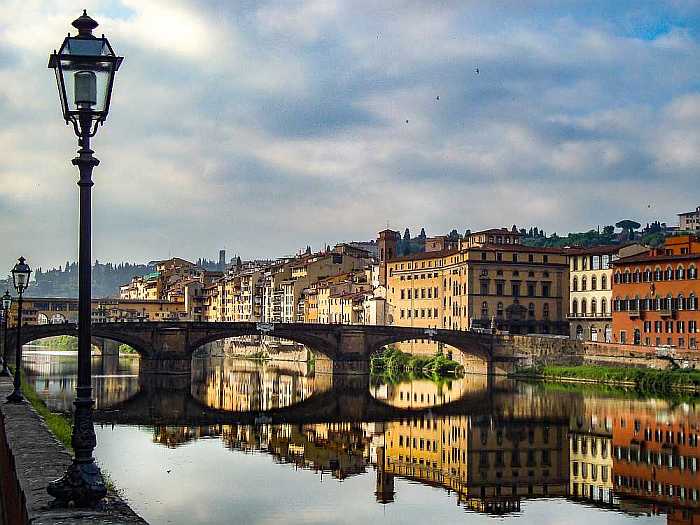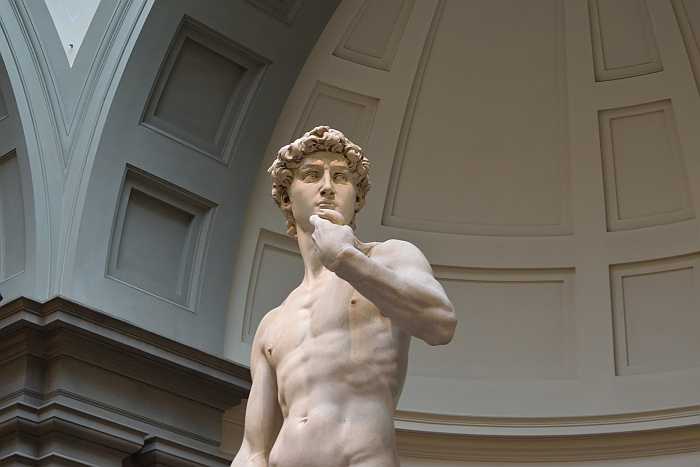
The Arno River (Photo: Pixabay)
Florence is one of the main Italian destinations. Known as the world capital of the Renaissance and renowned for its art treasures and amazing architecture and monuments, Florence has its first record of Jews living within its boundaries dating back to the XII century. The peak of the Jewish presence was obviously reached in the XIV and XV centuries, centuries that saw the blossoming and the height of the Renaissance period, even though the ruling family of the Medici had never been particularly friendly towards the Jews, actually quite the opposite. Therefore, in addition to all the marvels and wonders that Florence has to offer, discover its Jewish imprint and history. While in Florence, there are a few kosher restaurants to choose from and synagogues if you are looking for a minyan or Shabbat arrangements.
Remains of the Jewish Ghetto
Our tour of Jewish Florence will start from Piazza della Repubblica which used to be the center of the old ghetto before it was demolished in the middle of the XIX century to give way to a remodelling of the whole area in anticipation of Florence becoming Italy’s second capital city after Turin in the immediate aftermath of the reunification of the Italian peninsula in 1861 and before Rome became the final capital city in 1870.
To find remains and artifacts from the ghetto we will have to take a walk through one of the most beautiful areas of Florence to reach nearby Museo San Marco. Here, all items and relics of any significance were collected and put on display after this area’s demolition was completed. On the way to the Museum, we will pass by sites linked to local Jewish history, including those of two old synagogues, one Italian and one Levantine, used until 1962 by those Jews who refused to move out of this area when the main synagogue was completed in 1882 and most of the Jewish population moved nearby its quarters.
To find remains and artifacts from the ghetto we will have to take a walk through one of the most beautiful areas of Florence to reach nearby Museo San Marco. Here, all items and relics of any significance were collected and put on display after this area’s demolition was completed. On the way to the Museum, we will pass by sites linked to local Jewish history, including those of two old synagogues, one Italian and one Levantine, used until 1962 by those Jews who refused to move out of this area when the main synagogue was completed in 1882 and most of the Jewish population moved nearby its quarters.

Dome of the synagogue in Florence (Photo: Pixabay)
The Jewish Museum & Synagogue
The tour into the Jewish Heritage will then take us to our last site, the Synagogue completed in 1882, a splendid architectural example of the period of Jewish emancipation with its monumental aspect and lavish decorations as to symbolise the long-awaited access of the Jewish population into the Italian social and civic mainstream. Inside the synagogue it also will be possible to visit the Jewish Museum, where the long and rich history of the Florentine Jews is on display.
The Market & Gardens
After discovering the Jewish culture, stroll to the foodie heaven of Florence: Mercato Centrale and indoor market where you will savour the flavours of locally sourced products, see the locals buying high quality products directly from the vendors and enjoy its typical, colourful, and animated atmosphere. For a little break from the noise of the city, you can immerse yourself in the hidden green gem of Florence: the gardens of Villa Bardini. Lesser known than Boboli gardens, it is the home of the beautiful staircase you can see from the Arno River. Walk through the olive grove or, if you’re lucky, visit during April when the magnificent purple wisteria arch is in bloom. Not far away from this spot is Piazzale Michelangelo from where you will be able to admire a fantastic bird’s eye view of Florence.
You cannot leave Florence without buying some presents for your family and friends: go to San Lorenzo Street stalls and shops selling high end leather hand-made products, one of the many artisanal products for which Florence and Tuscany are famous for. Moreover, if you are a little bit curious about leatherwork, you can head to the traditional leather school behind Santa Croce church where you will be able to experience firsthand the history and the working procedures of this ancient artisanal art.

David of Michelangelo in Florence (Photo: Pixabay)
The Uffizi Gallery
Last but not least, we will discover the art of the city in the most visited museum in Italy and one of the most visited worldwide: the Uffizi Gallery, one of the first modern museums. After the ruling House of Medici died out, their art collections were given to the city of Florence under the famous Patto di famiglia negotiated by Anna Maria Luisa, the last Medici heiress. The Uffizi gallery has been open to visitors by request since the sixteenth century, and in 1765 it was officially opened to the public, formally becoming a museum in 1865. It is famous worldwide for its outstanding art collections spanning from the Middle Ages, the Renaissance and the baroque periods. About a minute walk from here is also a much less known museum, but well worth visiting, dedicated to the famous astronomer Galileo who, for his discoveries, was excommunicated by the Church. But this is a completely different story worth telling separately.
Follow your bliss and go away from the usual attractions and explore the secrets and discover the role played by Jewish community in the capital of Renaissance: Florence.
Andrea Alcalay from La Tour I-Talya. LaTour I-Talya is a project established and managed by a team of Italian Jews working together with one of the largest and most prestigious Italian Tour Operators. LaTour I-Talya specializes in tour packages which focus on the amazingly rich Jewish historical and cultural heritage found throughout Italy.
Read more articles from our Hidden Gems of Italy series:
Echoes of the Past: Unraveling Trieste's Jewish Legacy
Beyond Rome: The Enchanting Villages of Anagni and Alatri
Explore the Charm of Casate Monferrato
Get in Touch with the oldest Jewish community in Tuscany
Mantua: First stop in the Renaissance cities of Northern Italy
Pitigliano: "Little Jerusalem" in the Tuscan Maremma Region
Cividale del Friuli: Jewish Tours of Italy off the Beaten Path
The Charming Padova (Padua)
The Marche Region: Undiscovered area of Central Italy
Andrea Alcalay from La Tour I-Talya. LaTour I-Talya is a project established and managed by a team of Italian Jews working together with one of the largest and most prestigious Italian Tour Operators. LaTour I-Talya specializes in tour packages which focus on the amazingly rich Jewish historical and cultural heritage found throughout Italy.
Read more articles from our Hidden Gems of Italy series:
Echoes of the Past: Unraveling Trieste's Jewish Legacy
Beyond Rome: The Enchanting Villages of Anagni and Alatri
Explore the Charm of Casate Monferrato
Get in Touch with the oldest Jewish community in Tuscany
Mantua: First stop in the Renaissance cities of Northern Italy
Pitigliano: "Little Jerusalem" in the Tuscan Maremma Region
Cividale del Friuli: Jewish Tours of Italy off the Beaten Path
The Charming Padova (Padua)
The Marche Region: Undiscovered area of Central Italy